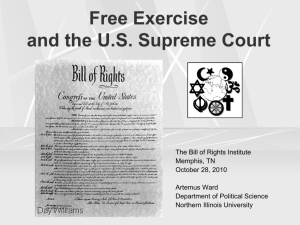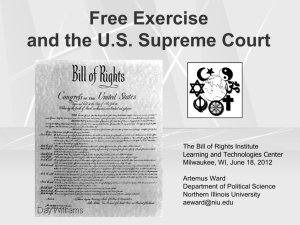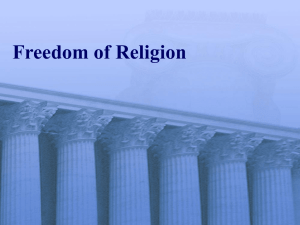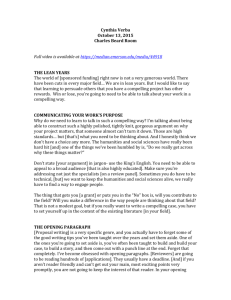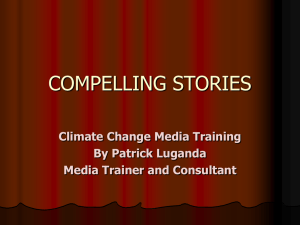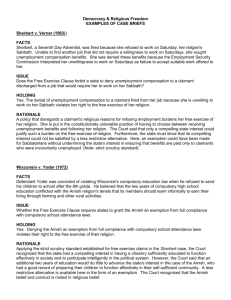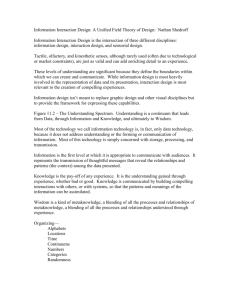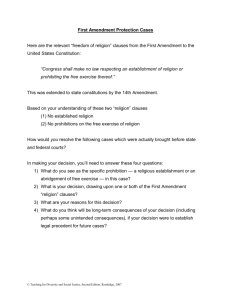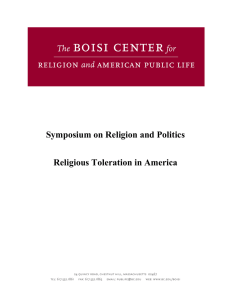Free Exercise of Religion - Northern Illinois University
advertisement
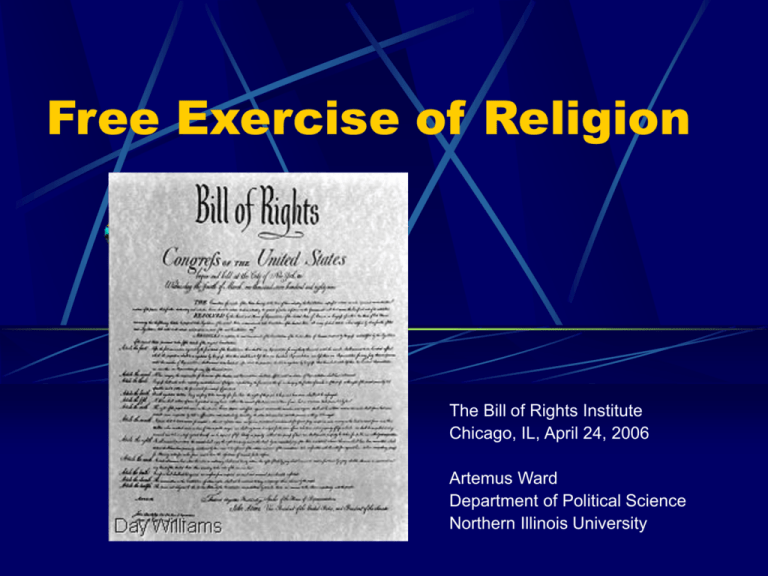
Free Exercise of Religion The Bill of Rights Institute Chicago, IL, April 24, 2006 Artemus Ward Department of Political Science Northern Illinois University First Amendment Congress shall make no law respecting an establishment of religion, or prohibiting the free exercise thereof . . . What is religion? What is true A sincerely held belief What was accepted as religion during the founding period What is longstanding, traditional A belief in divinity (supreme being), morality, and worship A belief that is not essentially a political, sociological, or philosophic view Big Love New HBO series Husband and three wives—each with children Is this a religious practice protected by the Free Exercise Clause? Reynolds v. United States (1879) 1830—Mormon church founded. 1874—U.S. Congress outlawed polygamy. In Reynolds v. United States (1879) the Court held that the polygamy was not protected by the Free Exercise Clause because it was not practiced when the First Amendment was adopted, i.e. Mormonism was not a religion because it was not contemplated by the framers. This ruling basically defined religion to a belief in God, in the Western sense. Defining Religion Later cases expanded the Reynolds definition from a “belief in God” to: “a sincerely held belief” in the case involving the “I Am” sect of Saint Germain in California: United States v. Ballard (1944), “moral and ethical” sincerely held beliefs in the Vietnam draft objector cases: United States v. Seeger (1965) and Welsh v. United States (1970). Cantwell v. Connecticut (1940) Cantwell and his sons, Jehovah's Witnesses, were in the streets of New Haven, a heavily Catholic neighborhood, playing records and handing out literature attacking the Catholic Church. Two men complained and the next day Cantwell was arrested. They were convicted of unauthorized solicitation (not petitioning a state official beforehand who had to determine whether “the cause was a religious one” or one of a “bona fide object or charity”; if the official found neither he could withhold the license). Can the state require a license for religious solicitation in public? Cantwell v. Connecticut (1940) The Court struck down the law because the state official was determining what was and was not a religion. The first Amendment “embraces two concepts - freedom to believe and freedom to act. The first is absolute but . . . conduct remains subject to regulation for the protection of society." For example, states can "regulate the times, the places, and the manner of soliciting upon its streets. . . and in other respects safeguard the peace, good order and comfort of the community." This is called the “valid secular policy test" – if there is a legitimate state interest, then regulations are allowed, even if they conflict with religious practices. Sherbert v. Verner (1963) Sherbert worked M-F in a textile mill for 35 years. Saturday work was optional and she always chose not to work because of her religious beliefs. She was informed that Saturdays would now be mandatory, didn't show and got fired. Other mills had mandatory Saturday work and did not hire her. She filed for unemployment and was denied because she was "able to work" as defined by the state unemployment statute. Her attorneys argued that the denial of benefits due to the Saturday work requirement impinged on her religious belief -- the state was using economic coercion to force her to give up her religious belief. Sherbert v. Verner (1963) Justice Brennan struck down the law, comparing it to a criminal statute: “The ruling forces her to choose between following the precepts of her religion and forfeiting benefits, on the one hand, and abandoning one of the precepts of her religion in order to accept work, on the other hand. Governmental imposition of such a choice puts the same kind of burden upon the free exercise of religion as would a fine imposed against appellant for her Saturday worship.” Sherbert v. Verner (1963) The Court applied strict scrutiny, i.e. “the compelling state interest” test: The burden of proof is on the state to prove that their interest in restricting religion is “compelling.” They cannot simply assert a reason, but must instead provide data, evidence, proof, etc. The state said that its interest was curbing fraudulent benefits claims. The Court said that the state had not provided any evidence that fraudulent religious claims were a problem. Wisconsin v. Yoder (1972) State required compulsory education to age 16 (10th grade). The Court said that “Amish objection to formal education beyond the eight grade is firmly grounded in . . . central religious concepts.” The Court applied the compelling interest test: “Whatever their idiosyncrasies as seen by the majority, this record strongly shows that the Amish community has been a highly successful social unit within our society, even if apart from the conventional ‘mainstream.’ Its members are productive and very law-abiding members of society.” Employment Division of Oregon v. Smith “The Peyote Case” (1990) Two Native Americans were fired from their jobs, as drug counselors at a private clinic, after ingesting peyote as part of tribal religious rituals. They were not charged with a crime. They were, however, denied unemployment benefits because of “work-related misconduct.” While many states and the federal government do not criminalize peyote use for religious purposes, others, such as Oregon, do criminalize its general use. Oregon allows its use only on a prescription basis. Employment Division of Oregon v. Smith “The Peyote Case” (1990) The Court upheld the denial of benefits. Justice Scalia wrote, “We have never held that an individual’s religious beliefs excuse him from compliance with an otherwise valid law prohibiting conduct that the state is free to regulate.” Scalia said that as long as the law was neutral—i.e. applicable to everyone—it was constitutional. Employment Division of Oregon v. Smith “The Peyote Case” (1990) Scalia explained that the “compelling interest” test from Sherbert v. Verner does not apply to criminal statutes. “Although we have sometimes used the Sherbert test to analyze free exercise challenges to such laws . . . we have never applied the test to invalidate one. We conclude today that the sounder approach in accord with the vast majority of our precedents, is to hold the test inapplicable to such challenges.” Employment Division of Oregon v. Smith “The Peyote Case” (1990) Scalia explained that the kind of rule the "compelling interest" standard would give us would provide a religious exemption from almost anything: compulsory military service, taxes, health and safety regulation such as manslaughter and child neglect laws, compulsory vaccination laws, drug laws, traffic laws, minimum wage laws, child labor laws, animal cruelty laws, environmental laws, laws providing for equality of opportunity for the races. He wrote: “The first amendment's protection of religious liberty does not require this.” Church of the Lukumi v. Hialeah (1993) Church members practice the Santeria religion, which originated in West Africa, came to Cuba, and then to the U.S. following the Cuban revolution. There are 50,000 practitioners in Florida and 100 million worldwide. Central to the religion is animal sacrifice (chickens, goats, sheep, turtles, etc.) at weddings, births, deaths, etc. The animals' throats are cut and often they are eaten later. Church of the Lukumi v. Hialeah (1993) The city of Hialeah, Florida enacted a series of ordinances limiting animal sacrifice, which it defined as "to unnecessarily kill, torment, or mutilate an animal in a public or private ritual or ceremony not for the primary purpose of food consumption." The city argued there were significant health risks and problems of feeding, housing, and disposing of remains when slaughtering a large amount of animals (perhaps 10,000 a year) in places not properly zoned (like slaughterhouses) for the activity. The city also expressed concern for inhumane treatment of animals. Church of the Lukumi v. Hialeah (1993) Justice Kennedy applied both the neutrality test from Smith and the compelling interest standard from Sherbert in striking down the law. If the law is not neutral, or generally applicable, the state must show a compelling interest. “The record in this case compels the conclusion that suppression of the central element of the Santeria worship service was the object of the ordinances. . . . No one suggests, and on this record it cannot be maintained, that city officials had in mind a religion other than Santeria.” Church of the Lukumi v. Hialeah (1993) In separate opinions, Justices Blackmun, O’Connor, and Souter explained that only the compelling interest test ought to be used. Justice Scalia and Chief Justice Rehnquist explained that only neutrality was required. In the subsequent cases City of Boerne v. Flores (1997) and Locke v. Davey (2004) the Court continued to struggle with this issue. These divisions leave Fee Exercise law in an unstable state. The positions of Chief Justice Roberts and Justice Alito will likely make the difference on which standard is used. Free Exercise Standards Liberal Conservative Standard Compelling State Interest Neutrality, General Applicability Presumption For Individual/Group State Standard Compelling State Interest Neutrality, General Applicability Cases Sherbert, Yoder Smith, Hialeah Current Justices Stevens, Souter, Ginsburg, Breyer Scalia, Kennedy, Thomas
